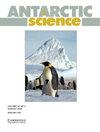南设得兰群岛乔治王岛东部渐新世-中新世序列的岩石地层学和年代研究,以及冰川事件与全球同位素事件的相关性
IF 2
4区 地球科学
Q3 ENVIRONMENTAL SCIENCES
引用次数: 6
摘要
摘要乔治王岛(南设得兰群岛,南极半岛)以其陆地古环境记录而闻名,其中包括可能长达四个新生代冰川期的证据。岛上冰川露头的一个优点是,它们与火山岩有关,可以进行同位素年代测定。通过一项新的测绘和年代研究,现在可以表明,乔治王岛东部许多地质单元的已发表地层学和年龄需要进行重大修订。Polonez冰川作用的年代为约26.64±1.43 Ma(渐新世晚期(查特阶)),包括以前被认为是始新世冰川作用证据的露头(“克拉科夫冰川作用”)。紧接着,在相对较短的时间间隔(<2 Ma)内形成了两个重要的火山事件(Boy Point和Cinder Spur组),这两个火山事件也在渐新世查特阶内爆发。梅尔维尔冰川作用的年代为约21-22 Ma(可能为21.8 Ma;早中新世(阿基坦阶)),勒格鲁冰川作用可能≤约10 Ma(晚中新世或更早)。这项研究的结果是,Polonez和Melville冰川作用现在可以分别与Oi2b和Mi1a同位素带的置信度增加相关联,因此代表了主要的冰川事件。本文章由计算机程序翻译,如有差异,请以英文原文为准。
A lithostratigraphical and chronological study of Oligocene-Miocene sequences on eastern King George Island, South Shetland Islands (Antarctica), and correlation of glacial episodes with global isotope events
Abstract King George Island (South Shetland Islands, Antarctic Peninsula) is renowned for its terrestrial palaeoenvironmental record, which includes evidence for potentially up to four Cenozoic glacial periods. An advantage of the glacigenic outcrops on the island is that they are associated with volcanic formations that can be isotopically dated. As a result of a new mapping and chronological study, it can now be shown that the published stratigraphy and ages of many geological units on eastern King George Island require major revision. The Polonez Glaciation is dated as c. 26.64 ± 1.43 Ma (Late Oligocene (Chattian Stage)) and includes the outcrops previously considered as evidence for an Eocene glacial ('Krakow Glaciation'). It was succeeded by two important volcanic episodes (Boy Point and Cinder Spur formations) formed during a relatively brief interval (< 2 Ma), which also erupted within the Oligocene Chattian Stage. The Melville Glaciation is dated as c. 21–22 Ma (probably 21.8 Ma; Early Miocene (Aquitanian Stage)), and the Legru Glaciation is probably ≤ c. 10 Ma (Late Miocene or younger). As a result of this study, the Polonez and Melville glaciations can now be correlated with increased confidence with the Oi2b and Mi1a isotope zones, respectively, and thus represent major glacial episodes.
求助全文
通过发布文献求助,成功后即可免费获取论文全文。
去求助
来源期刊

Antarctic Science
地学-地球科学综合
CiteScore
3.60
自引率
6.20%
发文量
42
审稿时长
3 months
期刊介绍:
Antarctic Science provides a truly international forum for the broad spread of studies that increasingly characterise scientific research in the Antarctic. Whilst emphasising interdisciplinary work, the journal publishes papers from environmental management to biodiversity, from volcanoes to icebergs, and from oceanography to the upper atmosphere. No other journal covers such a wide range of Antarctic scientific studies. The journal attracts papers from all countries currently undertaking Antarctic research. It publishes both review and data papers with no limits on length, two-page short notes on technical developments and recent discoveries, and book reviews. These, together with an editorial discussing broader aspects of science, provide a rich and varied mixture of items to interest researchers in all areas of science. There are no page charges, or charges for colour, to authors publishing in the Journal. One issue each year is normally devoted to a specific theme or papers from a major meeting.
 求助内容:
求助内容: 应助结果提醒方式:
应助结果提醒方式:


